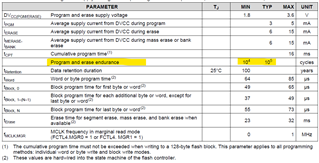Tool/software:
Hello,
I am working with the MSP430F6777A and need to periodically store data in its flash memory every 15 minutes. The data must remain reliably stored for the next 10 years, which amounts to approximately 350,000 write cycles.
According to the datasheet, the minimum program/erase endurance is specified as 10,000 cycles, while the typical value is 100,000 cycles. The large difference between these values raises some concerns, and I need to determine how many flash sectors I should allocate to distribute the wear and achieve the required endurance.
My Questions:
- What is the reason for the 10× difference between the minimum and typical endurance values?
- Does the minimum value (10K cycles) represent extreme conditions (e.g., very low/high temperatures, low operating voltage), or can failures still occur around this limit even under ideal conditions (e.g., 3.3V operation at 25°C)?
- If I had 1 million MSP430F6777A chips running at 3.3V and 25°C, would some of them start failing after just 10,000 cycles at 3.3V and 25C? or are those failures only expected under harsher conditions?
Based on these factors, I am trying to determine whether allocating 4 sectors is sufficient to reach 350K cycles, or if I need 40 sectors to ensure long-term reliability.
Thank you for your insights!

Thanks.

